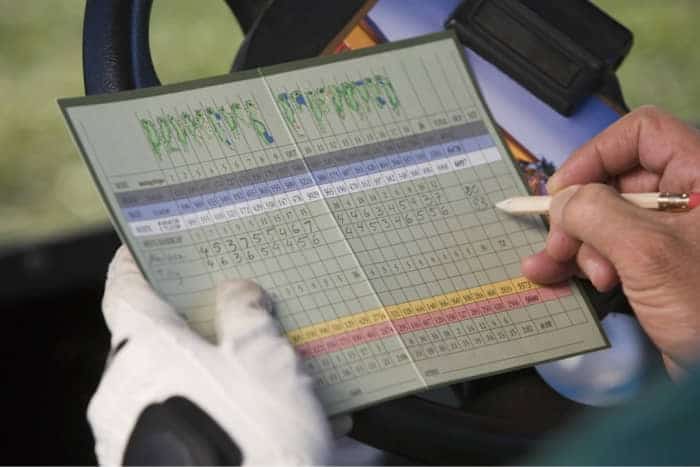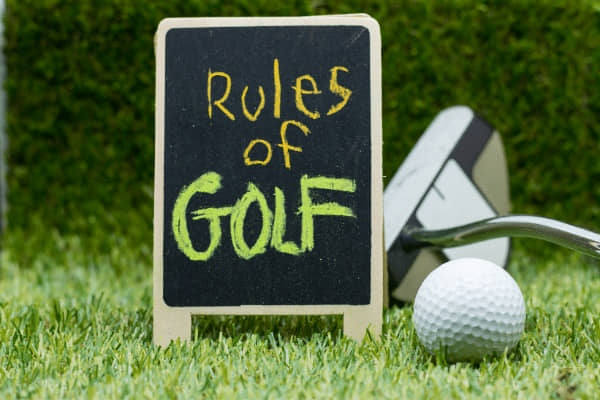When finding information to start playing golf, many people wonder, “How to score in golf?”
By knowing and understanding the score formula of golf, you will get yourself suitable strategies to win the game.
Therefore, it is very important to have a thorough concept of how this sport works. Let us help you with our precise guidance and advice for golfers.
First, let’s see the “scoring in golf” meaning!
What Is “Score In Golf?”
There’s no need to worry about the score in golf as its fundamental method is quite simple and easy to understand.
Many newbies and amateur players can even quickly count scores in some of their first days playing.
We use the term “a stroke” when a golfer swings to hit on a ball. You need to count any stroke you perform while playing.
Each time the golf ball rolls and hooks on the cup, please record and evaluate your entire strokes you performed on that specific hole on your scorecard.
This process will start after you finish with the final part of each hole during the game.
For example, on the first hole, a player has used six swings to drive the ball into the hole. His scored on the 1st hole is 6.
If that player needs to do five swings to the second hole, the ultimate score for his performance after this hole is 11.
This rule is the reason why you’ve seen golf players listing and counting each of their strokes during the game.
Additionally, before the match ends, all players will together calculate their whole hole scores. Remember, the score you can get is the ultimate number for that round.
How To Score In Golf – All Information And Methods
Now you have the basic knowledge about the scoring procedure during each match. We will continue with a more comprehensive explanation and ways to score in golf.
Start With A Golf Scorecard
Each round in golf, golfers have to play over eighteen holes. So, please keep in mind to record all your and others’ scores on your scorecard.
If not, you may miss some of your scores and lose the game. When focusing on the game, even some experienced players can miss without their scorecard.
Normally, you will be in charge of keeping your opponent’s score and vice versa.
After each round, you need to take a look to check their card and approve that the numbers in there are correct; then sign the card.
Every player has to repeat this process at the end of each round.
As a result, if the opponent miscalculates and worsens your score, you need to take responsibility for it. Many golfers prefer hiring a third party to get a designator.
This action will help ensure fairness during the game.
Understand The Golf Score’s Formats
Another main factor you need to learn is the golf score’s formats. Without understanding these formats correctly, you can’t calculate your entire score after a game.
There are usually three types of golf scoring: stableford, match play, stroke play.
Stableford: In this scoring system, you need to convert your score into points. And the total point is the ultimate number that decides whether you win the game or not.
Match Play: We will count and compare your score to the opponent’s score on every hole.
Between two players, who have fewer strokes, is the round’s ultimate winner.
Stroke Play: In this system, we count and write down every stroke on the scorecard.
Then, start tallying it up. Finally, the golfer with the lowest strokes will be the round’s winner.
Must-Known Tips
Next, we will provide you the two main tips for better performance to get your desired score in your games.
Count All The Purposeful Attempts
We can see that most of the time during each match (99,9%), a player has to interact with the golf ball.
But you can only count the score depending on the particular situation.
If you try to hit the golf ball and whiff, you can count it as a shot. However, if you practice swinging above the ball and accidentally hit it, it doesn’t count.
Therefore, each time you perform a swing on the ball, it will become a stroke, even if your performance is impressive or not.
In the “Par” section, we will list several strokes from each hole. It is the average figure of necessary strokes to drive the ball into the hole.
For instance, if the number for par is 3 and you performed a 4, your score will be 1-over. Similarly, the par is 80, and you achieved a 95; 15-over is your score.
Although it is not essential to know this information to keep score, every golfer should remember that a birdie equals one stroke, an eagle equals two strokes under par and one stroke for a bogey over par.
Some golfers decide not to perform more than a double bogey or two points over par for each hole.
Scoring in Match Play System
If necessary, you can skip a hole. Whenever you are having difficulties hitting the ball to a hole in a certain round, you can give up and continue the game with the next hole.
This action will help you save more sanity and energy. As a result, you play the next hole with a clean start.
Pay attention, observe and write down the winner of each hole after each round while continuing to play calmly.
When you are down a hole in a certain round, write -1 and vice versa (+1 for up).
If the numbers of balls in the hole of yours and opponents are equal, you can consider the result a draw, and under that hole, write “AS”.
On the other hand, when one player has more holes than the remaining holes, the game will come to an end.
For example, one player will be the winner with four holes while there are three remaining holes (after the fifteenth hole).
This rule is very important because the other player can’t win the round with enough holes in this case.
However, our advice is not to focus too much on how many shots you’re performing. Don’t be upset if you have to take too many chances to take shots.
The more important mission is to do your best to get as many balls in the hole as possible, especially if you are a beginner.
Using this strategy, you will quickly feel the rhythm of the game and score better.
Ways to Avoid Penalties In Game
For most sports, penalties are always the enemy of athletes. In golf, you need to keep your strokes at the lowest to win the game, while penalties raise the number of your strokes.
Therefore, it is very important to learn thoroughly about penalties in golf to avoid them successfully. Here are some of the most popular penalties.
Record wrong scores on the card. If a player writes down a lower number than the exact one, other players or the third party in the match can disqualify that person for making this mistake.
Players can’t ground your club in a hazard. If not, that person will get a penalty of two strokes. With his/her golf ball being in the water hazard, he/she will get one stroke for the penalty.
If a player loses the ball, he/she will also get a penalty with one stroke.
There are still various types of penalties in golf, so make sure you understand and remember all the fundamental ones.
Check Scorecard Again When You play
In golf, the final result in each round will depend on the stroke number. Thus, always remember to check your score before approving the scorecard with your signature.
In professional games, the opponents count the score.
So, you have to check the scorecard carefully one more time as soon as each round ends. By doing this step, you can avoid all unexpected circumstances.
Know About Golf Par
For the last part of this article, we want to emphasize the relation between golf bar and golf score.
This section will help you understand properly how to score and how to count the score in golf.
It is essential to compare the par score to a golf player’s score. Moreover, the entire score related to par in each round will report the score amount in the tournament.
If there is a par of 72 in a golf course and a new player performs 75 strokes to complete the course, we can say that the player has made more than three par strokes to finish that course.
Likewise, if the player needs to take only 70 strokes for the course completion, he/she has played less than a par two strokes to finish the course.
In golf, we can call it “two-under par”.
There are normally four rounds in a professional golf tournament. To become the winner, a golf player has to minimize bogey scores and strokes as low as possible.
Nonetheless, there are some special names in the golf score system.
Now, take a look at the list below.
- Albatross = three under par or -3
- Eagle = two under par or -2
- Birdie = one under par or -1
- Par = 0
- Bogey = one over score or +1
- Double Bogey = two over scores or +2
- Triple Bogey = three over scores or +3
Final Thoughts
As you can see, golf is an interesting sport, yet not quite easy for beginners. The newbies need to know and understand many rules to master golf.
Hopefully, you have a complete concept of how to score in golf after spending time on our article.
Besides our tips, we want you to know that many mobile apps can help you count the golf scores, if you’re afraid of making mistakes when calculating during the game.
They’re so helpful.
You can try one of them at least once for better preparation and mood before the match.




